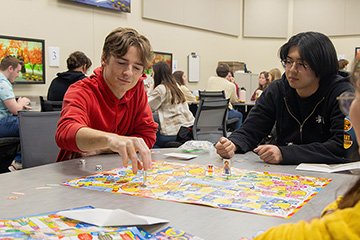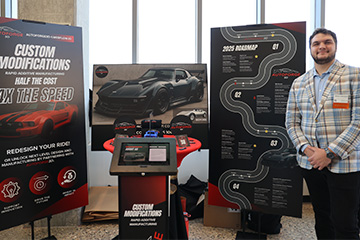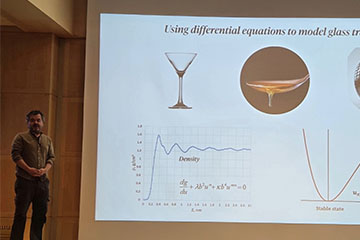Sound the gong for research
CMU Honors Program students partner with faculty to deeply explore their interests
Every once in a while, the first-floor hallways of Powers Hall at Central Michigan University ring with a loud clang, followed by the sounds of cheering and clapping. The noise comes from a dinner plate-sized gong hanging on the wall just inside the door of room 104, and some students wait years for their turn to ring it.
It’s the sound of CMU Honors Program students completing their senior capstone projects, announcing the culmination of all the knowledge and experience they’ve gained during the educational journey.
Most students begin working on a project proposal in their junior year, though some of the Centralis scholarship recipients begin as early as their freshman year, said Judy Idema, honors associate director. At any given time during the year, as many as 200 honors students are working on their capstone projects, collaborating with faculty partners on a variety of subjects.
The capstone focuses on a topic of the student’s choosing and must be submitted in a format such as a research paper or a creative endeavor. It’s a process that can take many hours each week — students can earn up to six credit hours when they submit the completed projects.
And simply finishing the project is insufficient: Students also must share their work in a professional setting, such as a conference or juried exhibition.
Many students presented their work during CMU’s annual Student Research and Creative Endeavors Exhibition in April.
Here’s a look back at just a few of the capstone projects that honors students completed this year, and more photos and stories are available in our Facebook gallery.

How can music makers appeal to diverse audiences? With guidance from School of Music instructor Evan Ware, music education major Alex Rodriguez, a senior from Jackson, Michigan, developed his capstone to inspire others to create music that will improve the lives of listeners.

Parkinson’s disease affects more than 10 million people worldwide. Working with Michael Sandstrom from the neuroscience program, Bellevue, Michigan, senior Erica Burkett created cells that may be used in the future to develop clinical interventions for patients with Parkinson’s.

Lateef Shafau, a biology major from Detroit, worked with Ute Hochgeschwender in the College of Medicine to examine the therapeutic benefits of a combination of swim therapy and bioluminescent optogenetic stimulation on spinal cord injuries in rats.

Suruchi Dash, a biomedical sciences and history major, and her twin sister, Suneeti, a biomedical sciences and anthropology major, wanted to empower aspiring physicians to help victims of domestic violence. Working with Brooke Oliver-Hempenstall, director of CMU’s Sexual Aggression Services, the seniors from Macomb, Michigan, developed a training program for future health care providers that covers advocacy as well as medical and legal responsibilities.

Predicting dangerous weather is tricky — and important. Adam Batz, a meteorology major from St. Johns, Michigan, worked with Daria Kluver from earth and atmospheric sciences to study the ability of a weather detection satellite, called the GOES-16 Geostationary Lightning Mapper, to detect lightning strikes during winter thunderstorms with snowfall.

What’s the role of fashion and clothing in developing countries? Working with fashion merchandising and design faculty member Michael Mamp, Sarah Merrifield, a senior studying both fashion and Spanish from Sterling Heights, Michigan, examined the effects of secondhand clothing imports in nations, like Costa Rica, whose economies may be suffering under the weight of U.S. hand-me-downs.




